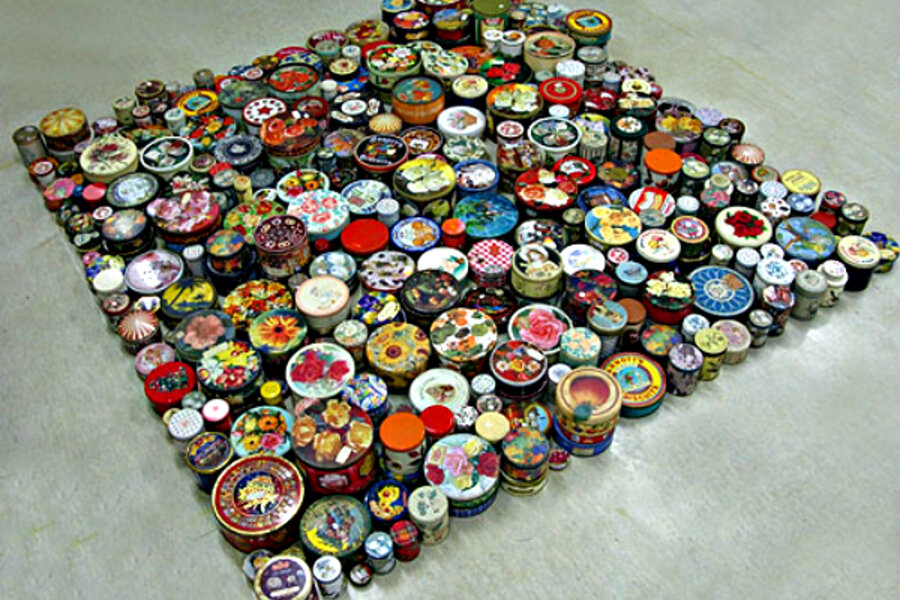Humble food meets high art
Loading...
The curated group exhibition "Art + Food: Beyond the Still Life" at Brenda May Gallery in Sydney, Australia, considers the representation of food within the visual arts and beyond the standard still life tableaux. The consumption of food is a universally shared experience, enabling people viewing the exhibition to connect with the issues surrounding consumerism, food production and cultural identity.
Some of the highlights include a large installation of biscuit tins amassed by the artist Christine Turner over a 15-year period as well as an installation by Sue Saxon and Jane Becker of hundreds of fragile eggshells on strands of lights. The show also includes a number of photographs featuring melting ice sculptures by Janet Tavener, the colourful remnants of meals by Vin Ryan and both a colourful and melting ice block by Will Nolan.
A sculpture composed of Murray River salt by Ken and Julia Yonetani will be offset by the artistic rendering of salt diffraction by Al Munro. The only traditional still life painting in the exhibition is by Michael Edwards who paints cement fruit which makes for a perfect pairing with the actual cast cement hamburgers by Will Coles.
The salt sculptures of Ken and Julia Yonetani consider the way food production affects the environment of the Murray River basin in southeast Australia, the origin of the salt used to construct the work. Likewise, Maz Dixon’s paintings and collages feature "The Big Things in Australia" highlighting the influence of the food industry on tourism by depicting some of the giant "sculptures" which litter the Australian landscape.
The beauty of some of the more traditional mediums of photography and sculpture is offset by works that leave the viewer feeling somewhat more uncomfortable. Claire Anna Watson’s film "Sortie" begins with a pair of tweezers plucking pips one at a time from a ripe strawberry. The film progresses to a dissection of the fruit that echoes the look and feel of a gory surgical scene. Sarah Field’s quaint tea set includes human hair and fur which recalls the surrealist Méret Oppenheim sculpture of a fur-covered tea set, "Object (Le Déjeuner en fourrure)" made in 1936.
For "Lifescapes," artist Christine Turner says, "I have found that biscuit tins require a simple configuration when presented in artworks. Each tin provides a great deal of information of its own. Information about societal customs, the economy, consumerism and much more." Most people, when viewing the work, circle the parameter recognising tins from their own mother’s and grandmother’s kitchens. The installation draws on people’s nostalgia for familiar things and a certain time or place.
“In our house, the biscuit tin was only brought out on the weekends for afternoon tea. A humble suburban ‘high tea’. One that I relished," says Turner. "Central to this ritual was the beautiful treasure trove … the Arnott’s biscuit tin. It came with a 3-pound ‘fancy assortment’ of our favourite biscuits, from the delicate Shortbread Cream, to the decadent Monte Carlo. We always ate the Monte Carlos first. Once the biscuit tins were empty they became ‘reliquaries’ for all manner of things. Needlework, gloves, letters, keepsakes of every kind.”
"Art + Food: Beyond the Still Life" is a Crave Sydney International Food Festival event. Artists include Senden Blackwood and Laura Mathias, Will Coles, Maz Dixon, Michael Edwards, Stuart Elliott (courtesy Turner Galleries, Perth), Sarah Field (courtesy Michael Reid at Elizabeth Bay), James Guppy, Irianna Kanellopoulou, Al Munro, Will Nolan, Vin Ryan (courtesy of Anna Pappas Gallery, Melbourne), Sue Saxon and Jane Becker, Robyn Stacey (courtesy of Stills Gallery, Sydney), Susanna Strati, Janet Tavener, Christine Turner, Claire Anna Watson, Elizabeth Willing and Ken + Julia Yonetani (courtesy Artereal Gallery, Sydney).
The exhibit is on display at Brenda May Gallery until Oct. 20.
Megan Fizell is the curator of "Art + Food: Beyond the Still Life."







